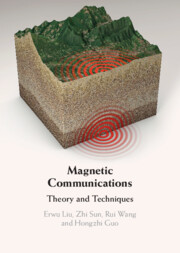7 - Magnetic Communication Networking Protocol Stacks
from Part II - Theoretical Basis
Published online by Cambridge University Press: 04 January 2024
Summary
Magnetic communication is a novel physical communication technology. To connect a large number of magnetic communication devices, traditional networking protocols can be employed, but we need to make significant modifications on the physical layer to accommodate the special features of magnetic communication. For example, to access the communication medium, traditional carrier-sense multiple access or Zigbee can be adopted, but the magnetic communication has a short communication range, and the antennas of different devices may have substantial coupling, which can affect the communication performance. To address this issue, we need dedicated scheduling algorithms to reduce mutual couplings among coils and increase the network throughput. In this chapter, we first introduce a complete magnetic communication network stack. Then, we show the unique features of magnetic communication at the network level. After that, we introduce the scheduling algorithms for magnetic communication networks.
Keywords
- Type
- Chapter
- Information
- Magnetic CommunicationsTheory and Techniques, pp. 150 - 162Publisher: Cambridge University PressPrint publication year: 2024

